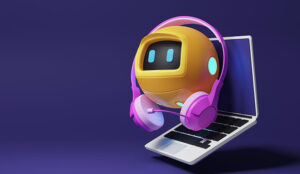Whitney Rose at Assembled provides a brief history of AI in customer support.
With so much buzz around AI in customer support these days, it might feel like this is an entirely new frontier for the industry.
Zoom out, however, and you’ll begin to understand that this recent wave of AI interest isn’t this technology’s first customer support rodeo.
The foundations of AI in customer support can be traced back several decades. In the 1960s, in its infancy, AI was more an idea than a practical tool. Yet, there were early indications of its potential in human-computer interactions.
Systems like ELIZA, which were incredibly limited by today’s standards, offered a glimpse of the potential for computers to mimic human conversation.
While ELIZA was designed more as a curious experiment than a customer support tool, its implications were far-reaching — suggesting a future where machines could simulate human-like interactions.
In other words, ELIZA walked so today’s chatbots could run.
By the time the 1980s came around, the telecommunication revolution was in full swing. This is when interactive voice response (IVR) systems saw their integration into customer service.
IVRs use pre-recorded or synthesized voices to guide users, answer basic queries, and route calls. Though not inherently “intelligent,” these systems paved the way for the eventual fusion of AI with customer interactions.
Then, the internet era of the 1990s and early 2000s hit — and that’s when the customer support landscape really started to transform.
It was around this time that online chatbots stepped into the scene. Sure, they were simplistic, rule-driven tools, but they represented the dawn of digital, automated, 24×7 customer service.
These are the chatbots that laid the groundwork for the next generation of AI-enhanced bots — the ones that would leverage sophisticated algorithms for natural and intuitive interactions.
Happening at the same time, this giant leap for botkind was further catalyzed by the rise of natural language processing (NLP).
Rather than navigating tedious touch-tone IVR menus, callers could simply speak their issues and advanced systems, driven by NLP, would understand and respond as needed.
Before we continue this journey into the more recent history of AI in customer support, it’s crucial to highlight the role of machine learning (ML).
A subset of AI, ML enables systems to automatically learn and improve from experience without being explicitly programmed.
This “learning by doing” capability became the driving force behind the AI innovations we see in customer support today.
Rather than rigidly following predefined rules, ML-driven support tools constantly evolve. They analyze vast datasets from customer interactions, recognize patterns, and subsequently refine their responses.
This constant iteration allows for a more fluid, responsive, and adaptable customer support experience — one that gets smarter with every interaction.
By the time the 2010s rolled around, companies were inundated with data to feed into ML models.
This, coupled with big gains in computational power, allowed AI-powered technologies to rapidly evolve.
Predictive analytics started making waves, enabling support systems to anticipate user concerns before they even surfaced.
And sentiment analysis tools decoded human emotions from interactions, tailoring responses for a more empathetic and personalized support experience.
As we transitioned into the late 2010s and early 2020s, a particularly intriguing development in AI began to take center stage: generative AI.
Unlike traditional models that relied on predefined responses or rule-based systems, generative AI models have the capability to produce content that is entirely new — be it text, voice, or even visual content.
In the realm of customer support, the implications of generative AI are nothing short of profound.
Instead of being limited to a fixed set of responses or scripts, generative AI-powered chatbots and voice assistants can craft replies on the fly, adapting to the user’s unique inquiries in real-time. This means that customer interactions can be more dynamic and personalized than ever before.
Imagine a scenario where a user presents a complex, multifaceted issue to a support bot. Instead of navigating through a labyrinth of pre-determined prompts or getting a generic response, the user receives a detailed, contextually relevant answer generated on the spot by the AI.
This drastically enhances the user experience, making digital support interactions feel more “human.”
Furthermore, generative AI models can continuously learn from the vast swathes of data they interact with, ensuring that their responses are not just relevant but also up to date.
In an age where products, services, and user needs are perpetually evolving, this ability to stay current and adapt is invaluable.
Of course, as with any emerging technology, it’s important to tread with caution. The very power of generative AI — its ability to create content — also poses challenges.
Ensuring the accuracy of generated responses, and preventing the dissemination of misleading or incorrect information, is key.
Robust oversight mechanisms and a better-together mentality regarding the relationship between human expertise and AI capabilities will be crucial to harnessing the potential of generative AI responsibly.
Today, in the 2020s, we stand at a fascinating juncture. AI is no longer just an accessory to customer support — it’s quickly becoming the backbone.
The seamless integration of AI with other emerging technologies, like augmented reality and IoT, promises a future where customer support is proactive, personalized, and, above all, human-centric — despite being driven by machines.
The journey of AI in customer support is a testament to technological evolution, and how it has always been geared towards making human experiences richer and more fulfilling. There’s no doubt that the future holds even more exciting prospects.
This blog post has been re-published by kind permission of Assembled – View the Original Article
For more information about Assembled - visit the Assembled Website
Call Centre Helper is not responsible for the content of these guest blog posts. The opinions expressed in this article are those of the author, and do not necessarily reflect those of Call Centre Helper.
Author: Assembled
Published On: 7th Nov 2023 - Last modified: 23rd Oct 2024
Read more about - Guest Blogs, Assembled, Whitney Rose






 Assembled is a Support Operations platform that helps companies maintain exceptional customer experiences, no matter what lies ahead. Leading brands use Assembled's workforce and vendor management capabilities to make optimal staffing decisions, gain visibility into performance and productivity, and unlock new ways to serve evolving customer needs.
Assembled is a Support Operations platform that helps companies maintain exceptional customer experiences, no matter what lies ahead. Leading brands use Assembled's workforce and vendor management capabilities to make optimal staffing decisions, gain visibility into performance and productivity, and unlock new ways to serve evolving customer needs. 









